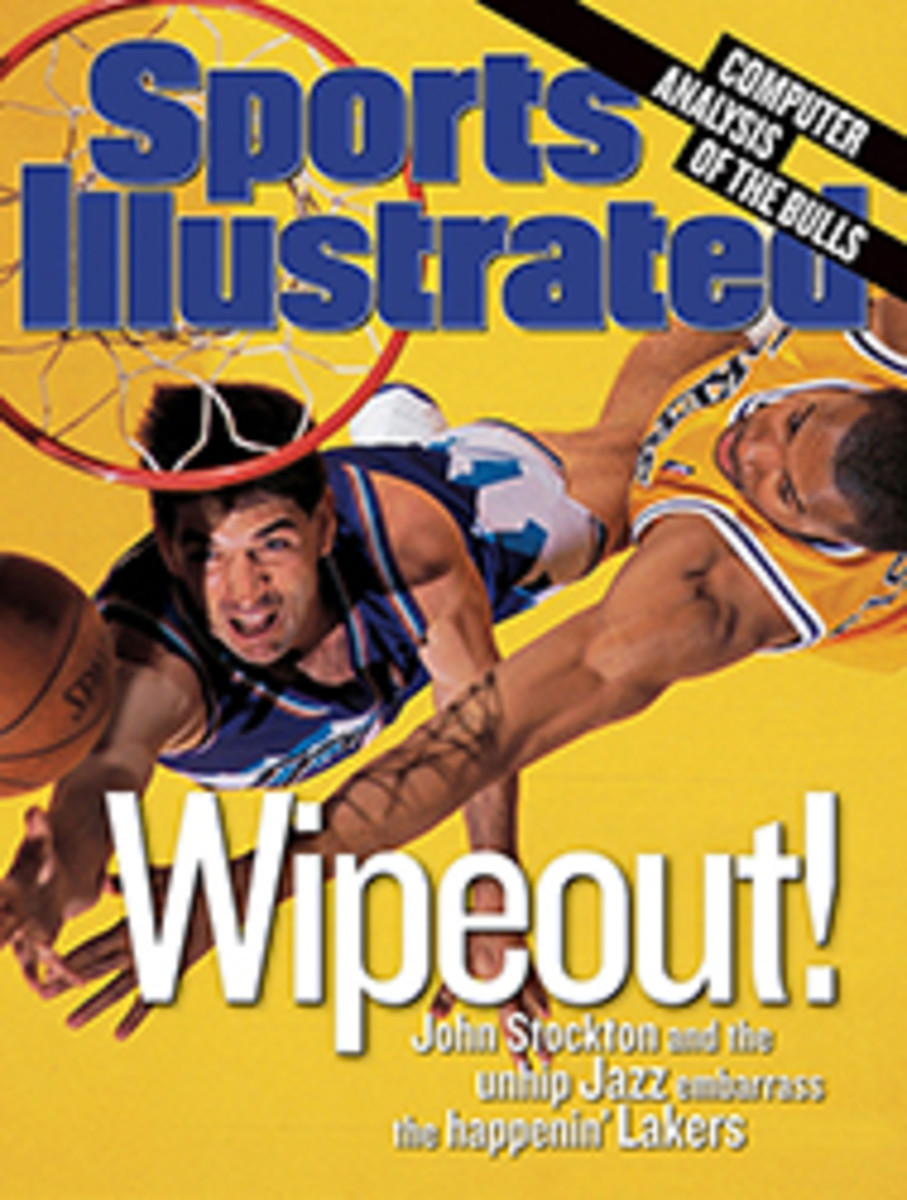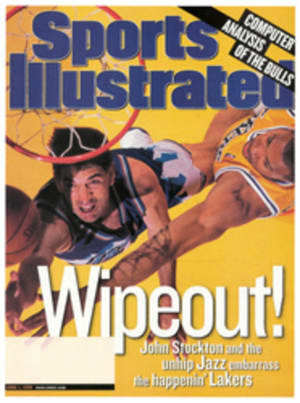
Inside Motor Sports
FORTUNATE 500
Another makeshift Indianapolis 500 is over, won by a man who was
winless in nine years on the Formula One circuit and 0 for 6
seasons on the CART tour, and whose previous best finish at Indy
had been fourth in 1992. "I'm glad that I've finally done
something in my career that will stick," Eddie Cheever said
after Sunday's race. "My father told me, 'If you're going to win
one race in your life, win Indy.'"
But even Cheever realizes he won a race that is three years
removed from being a world-class event. The guys he never could
beat don't show up at Indianapolis Motor Speedway anymore, and
the motley crew there on Sunday made this 500 reminiscent of the
Dust Bowl migration to California, what with so many stalled
vehicles along the way. Five of the 12 caution flags were for
cars that had neither wrecked nor blown engines, but had
suffered some lesser mechanical breakdown.
Defending IRL points champ Tony Stewart blew his engine just
seconds after taking the lead on Lap 21. Pole starter Billy
Boat, driving for Indy legend A.J. Foyt's team, battled
mechanical problems all day and left the race after 111 laps.
Foyt's other driver, Swedish upstart Kenny Brack, led 23 of 88
laps before running out of fuel, which prompted Foyt to yell at
his fuel-mileage specialist and smash the guy's laptop.
Defending champ Arie Luyendyk lost first gear early and then
blew his clutch on Lap 150. Plus, in a break with Indy
tradition, cars that had been taken to the garage area for
repairs were allowed to return to the race. In the 81 previous
runnings of Indy, once a car was taken behind the pit wall, it
was history.
What there was of actual racing was pretty good: 23 lead
changes, including three passes under the green flag for the
lead. But then there are some pretty good races on the short
tracks of Indiana, where several of this year's 500 competitors
had moonlighted during the two weeks leading up to Sunday's
race--yet another sign that the Indy field was not populated by
the elite.
Cheever, 40, is known around racing more for his glibness and
dashing persona than for his driving achievements. He's an
American who was raised in Italy, where his father, Eddie Sr.,
operated fitness centers. Cheever drifted toward Formula One,
but after going nowhere on road courses and street circuits he
moved to CART in 1990. "The first time I came to this place
[Indy's high-speed, 2.5-mile oval], it terrorized me," Cheever
says. "I wanted to go home." To this day, he admits, "I am still
learning ovals."
Which is the current nature of Indy. It is a place of learning,
of replacement players.
Safety Measure
INDY TESTS A PADDED WALL
First came helmets, then seat belts, then roll bars. In the
evolution of driver protection, now there's the "ultimate safety
device," as IRL driver Arie Luyendyk calls the latest innovation
for padding concrete retaining walls. The Polyethylene Energy
Dissipating System (PEDS), unveiled by the IRL at Indianapolis
last week, consists of energy-absorbing, hollow plastic
cylinders set side by side, covered with sheets of polyethylene
and attached to concrete walls with steel cables. Upon impact,
the 16-inch-diameter cylinders compress and then return to their
original shape, while the polyethylene facing prevents cars from
burrowing into them. PEDS appears to be a giant step beyond
CART's ongoing experimentation with tightly-banded stacks of
tires (SI, April 27) and promises to considerably reduce serious
injuries to drivers.
"In our testing the design has reduced the force of impact by as
much as 50 G's," says IRL executive director Leo Mehl.
Think of it this way: With the PEDS in place, NASCAR's Clifford
Allison (killed after hitting a concrete wall at Michigan
Speedway in 1992), Formula One's Ayrton Senna (killed after
hitting a concrete wall in Imola, Italy, in '94) and IRL's Scott
Brayton (killed after hitting a concrete wall at Indy in '96),
among others, might have survived their wrecks.
What's more, NASCAR's Ernie Irvan might not have had to make his
celebrated comeback from the life-threatening head and lung
injuries he suffered in a crash against the wall at Michigan
four years ago.
Only a 550-foot span of the padding was in place for Sunday's
Indy 500, and it was installed in a low-risk area of the
track--the inside retaining wall near the entrance to the pits.
Indy officials chose not to test the padding on the outside
retaining walls of each turn, which are considered the most
critical areas of impact, because "we've got to get a feel for
how it responds [at secondary-impact speeds] and if it performs
like we hope," says Kevin Forbes, director of engineering
facilities at Indy. If future tests go well, the outside walls
could be padded by next year.
CART Winner
ZANARDI PUTS DREAM ASIDE
Bent on driving in the Indianapolis 500, Alex Zanardi switched
from Formula One to CART in 1996. But by last Saturday he felt
prouder of beating Michael Andretti by a half second in the
Motorola 300 at little Gateway International Raceway outside St.
Louis than he would have felt if he had whipped all the no-names
in the Brickyard race on Sunday.
"Even if I went there and won, my colleagues would say, 'Hey,
you went to the kindergarten and kicked all the little kids,'"
says Zanardi, the reigning CART champion. "Or if I lost, they
would say, 'How couldn't you win that race?'"
That sentiment didn't exist when Zanardi left Monaco and the
Formula One circuit just three months before CART's first
boycott of Indy. "My only point of reference was the
Indianapolis 500," he says. "It was the most important part of
American motor sports history. Everybody in Europe is aware of
what that race is--or what that race was. Unfortunately it's not
the way it used to be. Now you would just go there for the
money. It no longer offers you the kind of prestige it used to.
I'm not saying that because I'm on CART's side of the wall. I'm
speaking of the world view."
NASCAR Repeat
PIT STRATEGY IS THE DIFFERENCE
Jeff Gordon made it clear after his win in Sunday's Coca-Cola
600 that if his crew chief, Ray Evernham, hadn't called for four
new tires on the final pit stop--the four drivers in front of
Gordon opted for rightside tires only, sacrificing grip for a
speedier stop--then his Chevy wouldn't have stood a chance
against the Fords. "I didn't see too many other Chevrolets out
there helping us out," he says. "The only real shot we had was
taking on four tires against their two tires."
Though Gordon spent the entire race among the leaders, he was
but one of five drivers who dominated the rest of the field. The
others--Rusty Wallace (Ford), Bobby Labonte (Pontiac), Mark
Martin (Ford) and Dale Jarrett (Ford)--combined with Gordon to
lead 327 of the 400 laps, and all four had begun to pull away
from him until a caution flag came out with 21 laps to go. The
five leaders pitted before the race resumed six laps later, and
Gordon quickly worked his way to second place. With nine laps to
go, he slipped past the front-running Wallace and went on to win
his second straight Coca-Cola 600 and his third Winston Cup race
this season.
Still, Ford placed second, fourth and fifth on Sunday, bringing
its top five finishes to 35 in 11 races this year, while Chevy
has 16 and Pontiac four. Says Evernham, "There are things our
team can do better to be competitive, but the Ford just is a
better race car." --Loren Mooney
For more racing news from Ed Hinton, go to www.cnnsi.com.
COLOR PHOTO: PHOTOGRAPH BY MICHAEL SCHUMACHER/REUTERS FENDER RENDER Jim Guthrie's car (foreground) crashes into that of Sam Schmidt in Turn 3 at Indy during the 500. The worst injury suffered by either driver was a broken arm (page 94). [Leading Off]
COLOR PHOTO: CHUCK ROBINSON/AP CLOSE CALL Cheever (far left) and J.J. Yeley were lucky to escape the first lap unscathed. [Eddie Cheever's car and J.J. Yeley's car driving by two skidding cars in race]
COLOR PHOTO: MARY BUTKUS/AP GETTING A LIFT A quick final pit stop gave Zanardi the edge he needed to win narrowly in St. Louis. [Alex Zanardi in car being worked on in pit stop]
FAST FACTS
Rookies, as a group, had their best day ever at Indy on Sunday
when six of the eight first-time 500 drivers finished in the top
12, including two in the top 5. Here are the five most
successful rookie classes over the past 15 years, and the
first-timers who were among the leading dozen.
ROOKIES IN
YEAR TOP 12 HIGH FINISHERS
1998 6 of 8 Steve Knapp (3), Robby Unser (5),
Andy Michner (8), J.J. Yeley (9),
Jimmy Kite (11), Jack Hewitt (12)
1989 3 of 4 Bernard Jourdain (9), Scott Pruett (10),
John Jones (11)
1984 3 of 5 Roberto Guerrero (2), Al Holbert (4),
Michael Andretti (5)
1995 3 of 6 Christian Fittipaldi (2), Eliseo Salazar
(4), Alessandro Zampedri (11)
1987 3 of 6 Fabrizio Barbazza (3), Stan Fox (7),
Jeff MacPherson (8)
The Deal
5
Victories this season by the resurgent McLaren-Mercedes team,
which won Monaco's Grand Prix on Sunday. Including the 1997
finale, McLaren-Mercedes has triumphed in six of the last seven
Formula One races after winning two of the previous 49.

